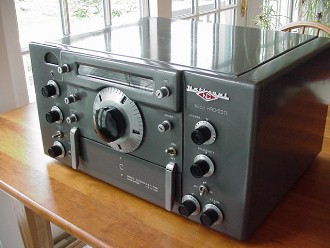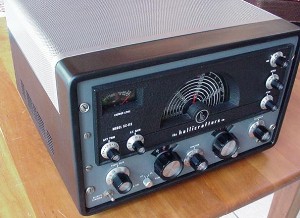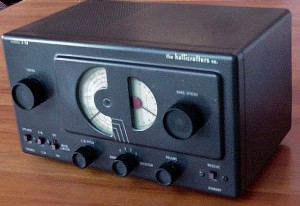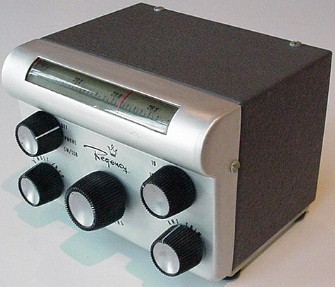|
|
Receivers |
|
|
Receivers |
I am partial to the receivers in my collection of vintage shortwave radios. Although modern receiver technology bears little resemblence to the primitive designs of a half-century ago, some early receivers were masterpieces of workmanship and engineering. Below is a sampling of receivers from my collection that have historical significance or were technological pace-setters.
(page revised August 2005)
| The National Radio Company's HRO-600 was the final entry in the venerable "HRO" line of VLF/HF communications receivers. Using state-of-the-art circuit concepts, the radio represemted the best of 1970 RF engineering. CLICK HERE or on the photo to learn more about this fascinating and rare all-band receiver. | |
 |
This National Radio Company HRO-50 predated the HRO-600, shown above, by about twenty years. The HRO-50 featured the clever "PW" tuning knob. Windows on the knob skirt contionuously updated the number of divisions as the knob was turned. How it worked is often a mystery, even to those of us (I ain't naming names) who took apart a PW knob and studied its innards. The HRO-50 was also known for its powerful audio, a result of push-pull 6V6 amplifier tubes. Note that frequency bands were selected by plugging tuned circuit modules into the front panel. National supplied wooden display cases for the modules, and collectors of this radio often have ten or more modules. |
| The beautiful SX-115 is the most sought after Hallicrafters receiver, next to the legendary SX-88. Sold in the early 1960s, the SX-115 was the pinnacle of Hallicrafters vacuum tube engineering. It was intended as a mate for the upscale HT-32B SSB transmitter. Although the company saw the receiver as a competitor for the Collins 75A4, its demise was primarily caused by the development of a new breed of lightweight receivers, principally the Drake 1A. (The SX-115, although not considered a heavyweight for its time, tipped the scales at 44 lbs.) Although some find the dial difficult to read, it is a very fine SSB/CW receiver. |  |
 |
Thousands of beginners got their start in amateur radio with this Hallicrafters S-38 six tube single conversion receiver. Produced from 1946-1949 with a selling price of about $40, the "S-38" series was followed by improved versions, until production ceased (with the S-38E) in 1961. The receiver drifted, wasn't sensitive on the high frequency bands, had inadequate bandspread, and deplorable selectivity, but to 14 year-olds who paid for it by mowing lawns it was a great launching point for a lifelong interest. |
| The little Regency ATC-1 ham band converter is destined to become one of the most prized items in any collector's stable of radios. Sold in 1956 by the same company that had invented the all-transistor TR-1 AM radio just two years earlier, the ATC-1 is amateur radio's first transistorized product. A masterpiece of clever engineering, it featured a rotating dial drum, BFO, linear bandspread, Q-multiplier, and excellent stability -- and all with just two transistors. |  |
|
This Multi-Elmac PMR-8 was one of a series of inexpensive mobile receivers that became popular during the 1950s. Although their circuitry was not particularly innovative, the mechanical layouts of these tiny radios were first class examples of good engineering. CLICK HERE or on the photo to learn more. |
|
|
The Morrow MB-6 is a rarely-seen mobile receiver, made from 1957-58. Despite its compact size, the radio features a 13 tube circuit and excellent performance. CLICK HERE or on the photo to check it out! |
|
|
The Mosley CM-1 is an entry-level amateur band receiver manufactured in 1961. This little-known five-tube wonder was the only venture into radio manufacturing by Mosley Electronics, a venerable company known worldwide for its antenna products. Surprisingly, the CM-1 featured clever engineering and outstanding performace. CLICK HERE or on the photo to learn more about this little odd duck radio. |
|
|
This 1966 Davco DR-30 receiver represented a breakthrough in receiver technology. Fewer than 600 of these seven-pound marvels were manufactured. CLICK HERE or on the photo to learn more about this remarkable receiver. |
|
|
Shown at the left with its matching speaker is the beautiful Hammarlund PRO-310 communications receiver. This rare receiver was manufactured in 1955-57. CLICK HERE or on the photo to learn more about this unusual radio. |
|
|
This Drake MSR-2 receiver (right) dates from 1977-78. In its day, at a cost of $5000, the MSR-2 was one of the world's finest communications receivers. Thanks to a low frequency tuned preselector, the radio has excellent performance in the 10 - 500 kHz range. CLICK HERE or on the photo to see more. |
|
|
Another rack-mount receiver, the sophisticated Collins HF-2050, is shown at the left. These late-'80s Canadian-made communications receivers were intended for military customers. Fewer than twelve hundred were manufactured. CLICK HERE or on the photo to see more. |
|
|
The RME-6900 (right) and matching speaker dates from 1959-62 and may be the last of the famous RME receivers. (Reputedly, RME made a model 6902, but I've never seen one.) The RME-6900 is a 12 tube ham-band-only receiver. |
|
|
|
You can get a hernia lugging this 45 lb RME-45 receiver (left) off the shelf, as I almost did when I took this photo.The RME-45 dates from 1946 -1948. It is a single conversion superhet design with 10 tubes, and covers .54 MHz to 33 MHz in six bands. Its 3 watt 7C5 audio output stage can blow your socks off. |
|
The Drake Model 1A ham band receiver (right) was manufactured between 1957-59 by the R.L. Drake Company, then in Miamisburg Ohio (now in Franklin, OH). The 1A is historcially significant, because it reversed the wisdom of the day that large, heavy receivers were needed for reliability and stability. Weighing a fraction of its Hallicrafters, Hammarlund, and National peers, but with superior performance, the Drake 1A spawned a new era in communication receiver design. CLICK HERE or on the photo to learn more about this pacesetting receiver.
|
|
|
The right photo shows four short-wave receivers. Clockwise from the top left are a Hammarlund HQ-215, a Drake DSR-1 (closeup, below), a National HRO-500 and LF-10 preselector, and a homebrew receiver I built in the 1970s. Below is a Drake DSR-1, a table-top version of the MSR-1 and MSR-2, listed above.
|
|
|
|
|
|
Three vacuum tube receivers and matching speakers, dating from the late 1940s to the early 1960s. From the top: Collins 75A-1, RME 4350A, and Hammarlund HQ-180AC. |
This Collins 75A-4 receiver (s/n 5609) sits atop its matching 1000 watt KWS-1 transmitter (s/n 150). The pair were known as the "Gold Dust Twins" when introduced in the mid-1950s because only affluent amateurs could afford their $2500 price tag. |